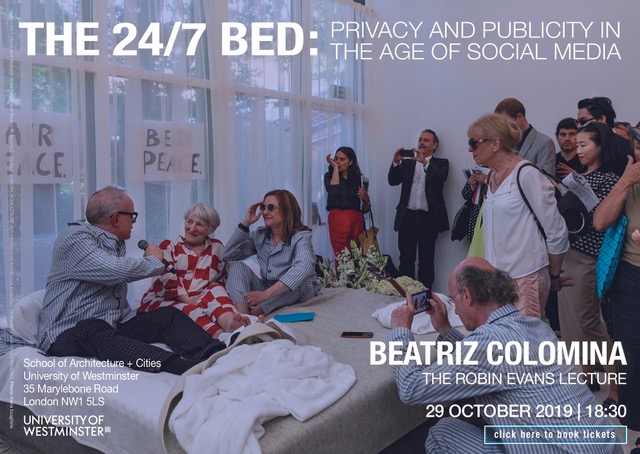The Robin Evans Lecture in which Beatriz Colomina, acclaimed author and curator, will draw on references ranging from John Lennon and Yoko Ono in Bed for Peace to the all-in-one home called Suitaloon, her own interview with Hans Ulrich Obrist and co-curatorships in Venice Biennale and Istanbul. The book by Colomina Sexuality and Space is known to a generation.
About the Speaker
Beatriz Colomina is the Howard Crosby Butler Professor of the History of Architecture at Princeton University and a 2018–2019 fellow at the Wissenschaftskolleg zu Berlin. She writes and curates on questions of design, art, sexuality and media. Her books include Sexuality and Space (Princeton Architectural Press, 1992), Privacy and Publicity: Modern Architecture as Mass Media (MIT Press, 1994), Domesticity at War (MIT Press, 2007), The Century of the Bed (Verlag fur Moderne Kunst, 2015), Manifesto Architecture: The Ghost of Mies (Sternberg, 2014), Clip/Stamp/Fold: The Radical Architecture of Little Magazines 196X–197X (Actar, 2010), Are We Human? Notes on an Archaeology of Design (Lars Muller, 2016). She has curated a number of exhibitions including Clip/Stamp/Fold (2006), Playboy Architecture (2012) and Radical Pedagogies (2014). In 2016 she was co-curator of the third Istanbul Design Biennial. Her latest book is X-Ray Architecture (Lars Muller, 2019).
About the Lecture Series
This series supports outstanding scholarship in the history of architecture and allied fields, building on the work of Professor Robin Evans (1944-1993). It encourages scholars working on the relationship between the spatial and social domains in architectural drawing, construction and beyond. Evans’ work interrogated the spaces that existed between drawing and building, geometry and architecture, teasing out the points of translation often overlooked. From his early work on prison design and domestic spaces, through to his later work on architectural geometry, Evans sought to articulate the multiple points at which the human imagination could influence architectural form. His first book, The Fabrication of Virtue, analysed the way that spatial layouts provided opportunities for social reform via their interference with morality, privacy and class. In The Projective Cast: Architecture and its Three Geometries, Evans traced the origins of the humanist tradition to understand how human form influenced architectural drawing and construction, focusing on aesthetic dimensions in the production of architectural space. This series will provide opportunities for the creation and/or dissemination of work by scholars working on similar questions of space, temporality, and architecture. In particular, it supports work that breaks the boundaries of traditional disciplines to think though these complex networks involved in the space between human imagination and architectural production.










